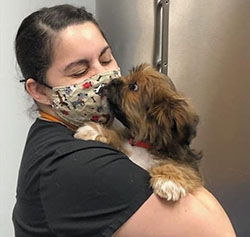Rehabilitation Services
 Trained Rehabilitation Therapist
Trained Rehabilitation Therapist
About Dr.Flanagan
Dr. Melissa Flanagan has gone through training in physical rehabilitation. She has studied the various modalities and techniques with the Canine Rehabilitation Institute. She truly enjoys helping animals recover from things as simple as post-operative care to more serious debilitating diseases.

Laser Therapy
Laser stands for “light amplification by stimulated emission of radiation.” Lasers are commonly divided into therapeutic lasers or medical lasers. The light from the laser is applied to the affected area, and influences cell or tissue functions. Low-level laser therapy (LLLT) is simply the stimulation of tissue with low energy lasers to achieve a therapeutic effect. Some indications for laser therapy are:
- wounds/lick granulomas
- pain
- inflammation
- arthritis
Therapeutic Massage
Therapeutic massage is usually performed in conjunction with other modalities to enhance the effects. Therapeutic massage can improve circulation, reduce muscle knots and spasms, reduce pain, and reduce anxiety or stress. There are several techniques used in canine massage therapy. The various techniques can be used to target a specific area or desired benefit depending on the patient that is being treated.
Electrostimulation Therapy
NMES—Neuromuscular electrical stimulation
Neuromuscular electrical stimulation is the application of an electrical current to elicit a muscle contraction. The main purpose of NMES is muscle strengthening. It is often used when a muscle can’t or won’t contract voluntarily. During NMES, an electrical impulse is delivered through electrode pads that are placed on the skin over the targeted muscle(s). These impulses encourage the nerves and muscles to retain normal function. NMES can also be used to improve the quality of a muscle contraction. Some indications for NMES include:
- reducing disuse atrophy (post surgery or injury)
- reversing muscle atrophy
- strengthening selected muscles (muscular re-education)
In Water Treadmill (Ferno System)
Hydrotherapy
Hydrotherapy has been proven effective in both equine and human rehabilitation for more than fifteen years and has quickly gained acceptance in the canine world since its first use in 1998. The water buoyancy decreases excessive force on the joints and provides resistance throughout the range of motion and provides the ability to strengthen the patients muscles. The temperature in our hydro-treadmill stays between 94-98 F. The warm water assists in pain reduction, increases blood flow and circulation, and helps with the elasticity of soft tissue. The water height is easily adjustable and is regulated to accommodate different sized animals and their specific needs. Some benefits of the hydro-treadmill include:
- weight loss- conditioning
- improves recovery time post-surgically
- strengthens muscles
